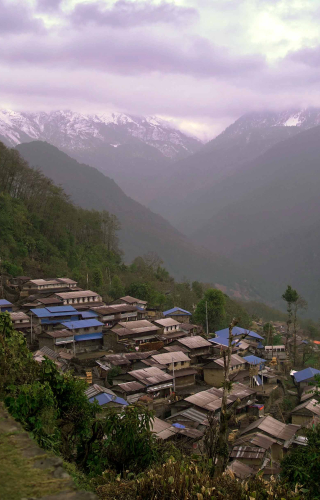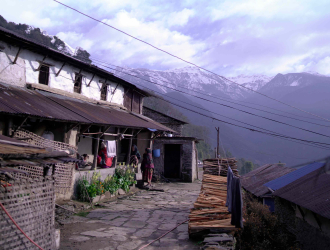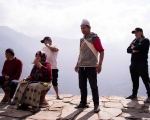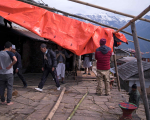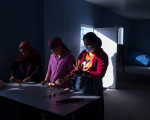A couple of years ago, I was invited by a friend to attend the Tamu Losar celebrations in Delhi. Tamu Losar or the Gurung New Year is an annual festivity which is celebrated with much gusto by the Gurung community. From ethnic dances and folk songs to a scrumptious spread of food and customary photo ops, it was a vibrant view of a warm and welcoming culture.
That was my first interaction with the Gurung community. Over time, I dug deeper into the cultures and traditions of the Gurungs to know more about their homeland in central Nepal. I also discovered that the Gurungs have served in the Gorkha regiments of the Indian and British army since 1815. As a result, a significant diaspora of the community now resides in various parts of India.
I chose to photograph the Gurungs because, much in contrast to their fierce reputation as warriors, I found them to be very friendly and open-hearted. I also wanted to understand the syncretic religion they follow, which is a mix of Hinduism, Tibetan Buddhism and Bon.
I finally decided to travel from Delhi to Nepal via road earlier this year, which took a little more than a day, including an overnight stay in Lucknow. After reaching Pokhara, I visited a couple of nearby Gurung villages in the first few days to identify potential subjects. After talking to members from the community, I eventually zeroed in on Sikle, a Gurung-dominated village in Kaski district of western Nepal.
The Gurung community at Sikles is primarily engaged in agriculture and animal husbandry, though some of the people have also tapped into the emerging trekking potential of the region. Almost every household in Sikles has family members working with the armed forces, either British, Nepali or Indian, or have simply migrated overseas in the hope of a better future. This is beautifully expressed in a very famous Gurung folk song titled ‘UK tira jauli’, which I heard over and over in Sikles.
During my stay at Sikles, I was invited by Mr Lok Bahadur Gurung (a resident of the village) to be part of a three-day funeral ceremony known as Arghum (alternatively called Pae and Arghun) that his family was organising following the demise of his father, late Mr Pas Bahadur Gurung.
For most communities, death rituals are a private affair, closed to outsiders. However, among the Gurungs, the culture is remarkably different. During Arghum, the entire clan of the deceased person comes together and takes part in performing rituals, accompanied by community dancing and feasting. What is more surprising is that Gurung women are equal participants in many rituals, which was a welcome change for me as a woman since most Hindu funeral ceremonies are performed only by men.
The Gurungs believe that the body and the soul of a person are two distinct entities and after death, while the body perishes, the soul lives on. The body is either cremated or buried within a day after death but to expedite the transmigration of the soul to the realm of the spirits, Arghum, which can be considered a second funerary ceremony, is arranged after some time. As a result, Arghum holds a special place in Gurung culture, where families make sure that it is conducted with utmost meticulousness.
During this intermediate phase, the fate of the soul is uncertain and it is appeased by making various offerings such as food, clothing and currency. It is a common belief that if the Arghum is not conducted with due diligence, the departed soul will wander unsatisfied among the living and bring misfortune to the family and the village.
Arghum is a three-day ceremony which is usually performed 45 days after death although in most cases, the time frame is not fixed and depends on the economic condition of the family. While in most of Nepal, Arghum is performed by the two groups of priests pachyu and kyabri, some sub-castes have their distinct systems. For instance, the Gurungs who belong to the Lama sub-caste often prefer to conduct the ceremony with Buddhist priests (called lamas). Pas Bahadur Gurung’s family that hosted me belonged to the Gothaney sub-caste and preferred the presence of kyabri priests of the Bon religion.
On the first day of Arghum, a flag (ala) is raised to mark the house of the deceased. Though no meat is consumed during this mourning period, the Gurungs perform sheep sacrifice. On the second day an effigy (pla) of the deceased person is raised where the women gather to mourn. After Arghum, this effigy is taken out to the highest point in the village where the soul is finally released. At this point, the priest advises the departing soul on its choice between reincarnation and remaining in the land of ancestors, and admonishes it not to return to the world of the living prematurely. Further prayers are made to the ‘spirits of the four cardinal directions’ for kind treatment as the deceased soul makes its way to the afterlife.
The three-day Arghum ceremony was a revelation to me in more ways than one. While the priests recited prayers from dawn to dusk and performed multiple pujas, the family hosted hundreds of their friends and relatives, some of whom came from nearby villages while others travelled from overseas. The three days at Mr Bahadur’s home saw constant activity and people engaged in specific tasks, depending on the relationship they shared with the deceased and based on their age.
Hosting Arghum can be an expensive affair for the mourning family. To ease the financial burden on the host, the entire village contributes in various ways, either through money or physical labour, and the expenses are shared among the extended family members. This way, Arghum not only honours the dead but also unites the living, strengthening social and economic ties in the community.
For me, it was a huge learning experience. I realised that death rituals form an important rite of passage, a way of integration into a larger social group. While the usual initiation ceremonies (of puberty, graduation, marriage, childbirth, etc.) happen during the lifetime of a person, death rituals connect the world of the living with the spiritual realms. The living and the dead depend on each other; the living for protection and the dead for periodic offerings, respect and commemoration. Even though we tend to overlook death rituals as cultural events because of the perceived sense of loss, it forms an important part in understanding social organisation and kinship.
I realised that a short two-week stay was not enough to understand the nuances of Gurung culture and I intend to return to Sikles and other Gurung villages, such as Tanting, Parche, Khailang and Gandruk, in western Nepal and spend more time with the community in the future.
